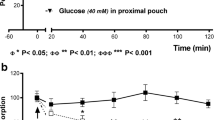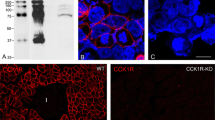Summary
Cholera enterotoxin introduced into the duodenum of young rabbits causes severe degranulation of the enterochromaffin (EC) cells as revealed by electron microscopy. In the mucosal epithelium fixed mainly 1 hr after toxin administration, many of the basal granules of the EC cells are swollen up and open to the basal and lateral cell surface. The EC cells of the rabbit, as it is the rule for intestinal endocrine cells in mammals, are open to the lumen with an apical process covered by microvilli. A hypothesis is proposed that cholera toxin stimulates this apical receptor of the EC cells and that the aminic (serotonin) and polypeptide (motilin?) products of the cells released by the stimulus may mediate the diarrhoeagenic action of cholera enterotoxin.
Similar content being viewed by others
References
Banwell, J. G., Pierce, N. F., Mitra, R. C., Brigham, K. L., Caranasos, G. J., Keimowitz, R. I., Fedson, D. S., Thomas, J., Gorbach, S. L., Sack, R. B., Mondai, A.: Intestinal fluid and electrolyte transport in human cholera. J. clin. Invest.49, 183–195 (1970)
Barbezat, G. O., Grossman, M. I.: Cholera-like diarrhoea induced by glucagon plus gastrin. Lancet1971 I, 1025–1026
Berridge, M. J.: The role of 5-hydroxytryptamine and cyclic AMP in the control of fluid secretion by isolated salivary glands. J. exp. Biol.53, 171–186 (1970)
Brown, J. C., Cook, M. A., Dryburgh, J. R.: Motilin: A gastic motor activity stimulating polypeptide: The complete amino acid sequence. Canad. J. Biochem.51, 533–537 (1973)
Carpenter, C. C. J., Sack, R. B., Feeley, J. C., Steenberg, R. W.: Site and characteristics of electrolyte loss and effect of intraluminal glucose in experimental canine cholera. J. clin. Invest.47, 1210–1220 (1968)
Davis, R. L., Girard, L.: Hormonal basis for the dumping syndrome. Rocky Mtn. med. J.71, 94–98 (1974)
Douglas, W. W., Nagasawa, J., Schulz, R.: Electron microscopic studies on the mechanism of secretion of posterior pituitary hormones and significance of microvesicles (“synaptic vesicles”): Evidence of secretion by exocytosis and formation of microvesicles as a byproduct of this process. Mem. Soc. Endocrinol.19, 353–378 (1971)
Elias, E., Polak, J. M., Bloom, S. R., Pearse, A. G. E., Welboum, R. B., Booth, C. C., Kuzio, M., Brown, J. C.: Pancreatic cholera due to production of gastric inhibitory polypeptide. Lancet1972 II, 791–793
Erspamer, V., Asero, B.: Identification of enteramine, the specific hormone of the enterochromaffin cell system as 5-hydroxytryptamine. Nature (Lond.)169, 800–801 (1952)
Field, M., Fromm, D., Wallace, C. K., Greenough, W. B.: Stimulation of active chloride secretion in small intestine by cholera oxotoxin. J. clin. Invest.48, 24 a (1969)
Finkelstein, R. A.: Cholera. CRC crit. Rev. Microbiol.2, 553–623 (1973)
Fujita, T., Kobayashi, S.: Experimentally induced granule release in the endocrine cells of dog pyloric antrum. Z. Zeilforsch.116, 52–60 (1971)
Fujita, T., Kobayashi, S.: The cells and hormones of the GEP endocrine system—The current of studies. In: Gastro-entero-pancreatic endocrine system. A cell-biological approach. (T. Fujita, ed.), p. 1–16. Tokyo: Igaku Shoin, 1973
Fujita, T., Osaka, M., Yanatori, Y.: Granule release of enterochromaffin (EC) cells by cholera enterotoxin in the rabbit. Arch. histol. jap.36, 367–378 (1974)
Gangarosa, E. J., Beisel, W. R., Benyajati, C., Sprinz, H., Piyaratin, P.: The nature of the gastrointestinal lesion in Asiatic cholera and its relation to pathogenesis: a biopsy study. Amer. J. trop. Med. Hyg.9, 125–135 (1960)
Kimberg, D. V., Field, M., Johnson, J., Henderson, A., Gershaw, I.: Stimulation of intestinal mucosal adenyl cyclase by cholera enterotoxin and prostaglandins. J. clin. Invest.50, 1218–1230 (1971)
Kobayashi, S., Fujita, T.: Emiocytotic granule release in the basal-granulated cells of the dog induced by intraluminal application of adequate stimuli. In: Gastro-entero-pancreatic endocrine system—A cell-biological approach (T. Fujita, ed.), p. 49–58. Tokyo: Igaku Shoin, 1973
Kraft, A. R., Tompkins, R. K., Zollinger, R. M.: Recognition and management of the diarrhoeal syndrome caused by nonbeta islet cell tumors of the pancreas. Amer. J. Surg.119, 163–170 (1970)
Matsumoto, K. K., Peter, J. B., Schultze, R. G., Hakim, A. A., Franck, P. T.: Watery diarrhea and hypokalemia associated with pancreatic islet cell adenoma. Gastroenterology50, 231–242 (1966)
Nagasawa, J., Douglas, W. W.: Thorium dioxide uptake into adrenal medullary cells and the problem of recapture of granule membrane following exocytosis. Brain Res.37, 141–145 (1972)
Osaka, M., Sasagawa, T., Fujita, T.: Emiocytotic granule release in the human antral endocrine cells. In: Gastro-entero-pancreatic endocrine system—A cell-biological approach (T. Fujita, ed.), p. 59–63. Tokyo: Igaku Shoin, 1973
Osaka, M., Sasagawa, T., Fujita, T.: Granule release from endocrine cells in acidified human duodenal bulb: An electron microscope study of biopsy materials. Arch. histol. jap.37, 73–94 (1974)
Pearse, A. G. E.: Common cytochemical and ultrastructural characteristics of cells producing polypeptide hormones (the APUD series) and their relevance to thyroid and ultimobranchial C cells and calcitonin. Proc. Rox. Soc.B 170, 71–80 (1968)
Pearse, A. G. E.: The endocrine cells of the GI tract: origins, morphology and functional relationships in health and disease. Clin. Gastroenterol.3, 491–510 (1974)
Pearse, A. G. E., Polak, J. M.: Immunocytochemical localization of Substance P in mammalian intestine. Histochemistry41, 373–375 (1975)
Pearse, A. G. E., Polak, J. M., Bloom, S. R., Adams, C., Dryburgh, J. R., Brown, J. C.: Enterochromaffin cells of the mammalian small intestine as the source of motilin. Virchows Arch. Abt. B.16, 111–120 (1974)
Pierce, N. F., Greenough, W. B., Carpenter, C. C. J., Jr.:Vibrio cholerae enterotoxin and its mode of action. Bact. Rev.35, 1–13 (1971)
Robison, G. A., Butcher, R. W., Sutherland, E. W.: Cyclic AMP. New York and London: Academic Press 1971
Sasagawa, T., Kobayashi, S., Fujita, T.: Electron microscope studies on the endocrine cells of the human gut and pancreas. In: Gastro-entero-pancreatic endocrine system—A cellbiological approach (T. Fujita, ed.), p. 17–38. Tokyo: Igaku Shoin, 1973
Schafer, D. E., Lust, W. D., Sircar, B., Goldberg, N. O.: Elevation of adenosine 3′, 5′ cyclic monophosphate concentration in intestinal mucosa after treatment with cholera toxin. Proc. nat. Acad. Sci. (Wash.)67, 851–855 (1970)
Serebro, H. A., McGonagle, T., Iber, F. L., Royall, R., Hendrix, T. R.: An effect of cholera toxin on small intestine without direct mucosal contact. Johns. Hopkins med. J.123, 229–232 (1968)
Sokoloff, B.: Carcinoid and serotonin. Berlin-Heidelberg-New York: Springer 1968
Solcia, E., Vassallo, G., Capeila, C.: Cytology and cytochemistry of hormone producing cells of the upper gastrointestinal tract. In: Origin, chemistry, physiology and pathophysiology of the gastrointestinal hormones (W. Creutzfeldt, ed.), p. 3–29. Stuttgart and New York: F. K. Schattauer 1970
Thompson, J. H.: Serotonin and the alimentary tract. Res. Commun. chem. Path. Pharmacol.2, 687–781 (1971)
Tobe, T., Kimura, C., Fujiwara, M.: Role of 5-hydroxytryptamine in dumping syndrome after gastrectomy: Histochemical study. Ann. Surg.165, 382–387 (1967)
Vaughan-Williams, E. M., Dohadwalla, A. N.: The appearance of cholergenic agent in the blood of infant rabbits infected intestinally withVibrio cholerae, demonstrated by crosscirculation. J. infect. Dis.120, 658–663 (1969)
Virchow, R.: Gesammelte Abhandlungen auf dem Gebiete der öffentlichen Medizin, Berlin,1, 151 (1879)
Warner, R. R. P.: Hyperserotoninemia in functional gatrointestinal disease. Ann. intern. Med.59, 464–476 (1963)
Author information
Authors and Affiliations
Additional information
This study was supported by the grants of the Ministry of Education of Japan.
Rights and permissions
About this article
Cite this article
Osaka, M., Fujita, T. & Yanatori, Y. On the possible role of intestinal hormones as the diarrhoeagenic messenger in cholera. Virchows Arch. B Cell Path. 18, 287–296 (1975). https://doi.org/10.1007/BF02889255
Received:
Issue Date:
DOI: https://doi.org/10.1007/BF02889255




